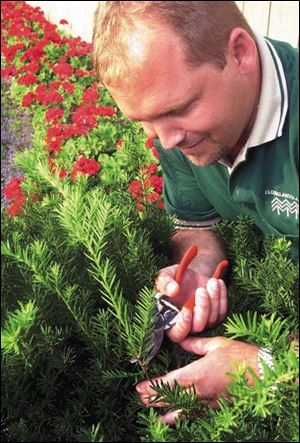
Shrubs look best when pruned with a light touch
8/1/2001Planning, planting, and pruning - it is a constant cycle.
But before you arm yourself with sharp pruners and head outside, make sure you also arm yourself with some pruning basics.
WHAT TO PRUNE
Pruning is like weeding: You don't want to do it if you don't have to - don't create more gardening chores than necessary.
When choosing new plants for your landscape, find something that will fit. Those cute little shrubs look dainty and sweet in the garden center right now, but give them a few years and they could grow to be about three feet wide and 10 feet tall.

Ron Isaacson demonstrates the correct way to prune a shrub.
Planning the landscape design and selecting the right species and cultivar for the intended effect sets the stage for the appropriate pruning style and practices, says Doug Bettinger, landscape designer and owner of FloraLandscape in Toledo. Always plan for the plant's mature size. By giving them enough room to grow in their natural form, you will spend less time chopping them down to fit into a space that was too small for it in the first place.
Light pruning can be done almost any time of the year, Mr. Bettinger says. Shrubs like taxus, junipers, burning bush, conifers, fall cypress and other broad leaf evergreens can be shaped up right now.
WHAT NOT TO PRUNE
Late summer or early fall usually isn't the best time to prune most bushes and trees. Plants are already struggling for what little moisture is available in hot, dry weather. Weakening them by removing many of their branches could permanently damage the plant, but light shaping won't hurt. Late fall or early spring is usually the best time to do any drastic shrub shaping. “This type of annual pruning is done to maintain plant shape or to remove dead, broken, weak, crossing or low-lying limbs,” says Mr. Bettinger.
Don't prune shade trees until after the weather has turned cold enough to kill of any fungus, bacteria, or insects that could infest those open wounds.
Don't prune that lilac bush yet. If a plant flowers before the end of June, prune it right after it flowers. “Most flower buds develop during the previous growing season,” says Mr. Bettinger. If you prune a lilac bush too early or too late, you will be cutting off the fragrant flowers that have already started to grow.
The same rule applies to other flowering ornamental shrubs. “You need to be careful when pruning rhododendrons and azaleas. Buds are forming on the tops of the branches right now. If you need to fix the shape of your bush, selectively thin out the heaviest growth, cutting it back to a grouping of leaves or a node. Always leave the tips of your rhododendron and azalea in tact since that is where next year's growth and flowers will be.”
Mr. Bettinger recommends waiting to prune plants like cotoneaster, pyracanthas, and viburnums since these plants usually are grown for their colorful ornamental fruits.
HOW TO PRUNE
You are a gardener, not a barber. Proper pruning means helping the plant stay healthy and maintain the shape that nature has intended. “Most people think pruning is cutting off the tips of their shrubs to create a uniform shape. That is not the best way to prune them unless you are trying to create a formal hedge,” Mr. Bettinger explains. The longest finger of new growth at the tip of each branch is called the dominant leader. Once that dominant leader is cut off, it sends a message to the plant to make the side or lateral shoots grow. That usually isn't the shape you are hoping for. Selectively thin some of the branches to let the sun hit all parts of the bush. You may need to cut three or four inches off the branch to help the bush retain its natural shape rather than a couple inches off the tip. Before you make your cut, look for a lateral node or a bump on the stem. Another good place is close to a grouping of leaves on the branch, or where two branches intersect. Make a clean diagonal cut snip about a quarter-inch from the spot you have selected.
Always use clean tools when pruning to prevent the spread of disease that may be lurking in the branches. If you suspect something is sickly, clean your pruners before and after each cut by dipping them in a mix of bleach and water, or rubbing the blades with an alcohol swab.
Low-maintenance landscaping may seem impossible, but if you let Mother Nature help design your garden, you may not have to do as much work to get the look you want.
“I have a spot in my yard planted with taxus, azalea, rhododendron, dogwood and a few other perennials,” says Mr. Bettinger. “I bet I spend about four hours a year pruning it. The plants are allowed to follow their natural growth pattern and I can sit back and prune at my leisure.”
Kelly Heidbreder is The Blade's garden writer. E-mail her at getgrowingkelly@aol.com.